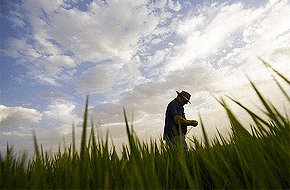
Australia’s ability to feed Asia is more limited than some people think according to analysts at CBA, even if Australia’s farm sector actually benefits from future Asian demand.
They point out that Australia’s area of quality farmland is limited and its farmland area is actually declining.
Over 60 million hectares of farmland have been taken out of production over the past two decades, equivalent to a loss of 13%.
That's an area twice the size of New Zealand (26.8 million hectares), and more than four times the total amount of New Zealand agricultural land in production (15.8 million hectares).
Some of this decline is attributed to urban encroachment, but more is attributed to retired land because of poor productivity and environmental considerations.
They point out that "existing soil constraints [and] limited water supplies ... obstructs opportunities", and even if they are overcome additional potential production will be very small.
And they remind readers that Australia’s recent yield performance is not encouraging.
Between 1970 and 2000 Australian wheat yields trended higher by 2.5% per annum, although from 2000 to 2012 yield growth slowed to just 0.3% per annum. More broadly, productivity growth in broadacre agriculture turned negative during the 2000s after growing by 1.6-1.8% pa in the 1980s and 1990s. Adverse seasonal conditions contributed to weak productivity performance, but more importantly, the slowdown reflects structural issues.
Western Australia, usually the country's biggest grain-growing state, has in fact become the epicentre of Australia's drought concerns, with their Climate Commission warning of a 15% drop in rainfall there since the mid-1970s, and the prospect of a further decline to come.
Rainfall patterns in Western Australia have changed over the last 40 years. There is significant evidence that climate change has contributed to the marked drying trend in the southwest of the state. This has had serious implications for urban water supplies and agriculture.
However, recent experience shows how a drier climate could reduce crop yields, pointing towards limits to our adaptive capacity. Following the very dry conditions that occurred across the Western Australian wheatbelt in 2010, production of wheat and other winter crops in 2010-11 was around 43% lower than production for the previous season.
Just how small Australia's key agricultural production is compared to current demand is instructive.
At current rates, China and India would eat Australia’s total wheat crop in little over a month. Likewise, Australia contributes less than 2% to global milk supply, less than 1% of global coarse grain supply and less than 0.2% to global rice supply. Our total rice supply is equivalent to just two days of current Chinese demand. If Australia were to produce enough rice to feed China for one year the entire state of Victoria would need to be converted to rice paddies.
Australia's only hope to benefit from the coming demand pull from an emerging and richer Asia is by the sale of its expertise, the authors say. Any increased production will be immaterial.
The research note is here ».

We welcome your comments below. If you are not already registered, please register to comment.
Remember we welcome robust, respectful and insightful debate. We don't welcome abusive or defamatory comments and will de-register those repeatedly making such comments. Our current comment policy is here.